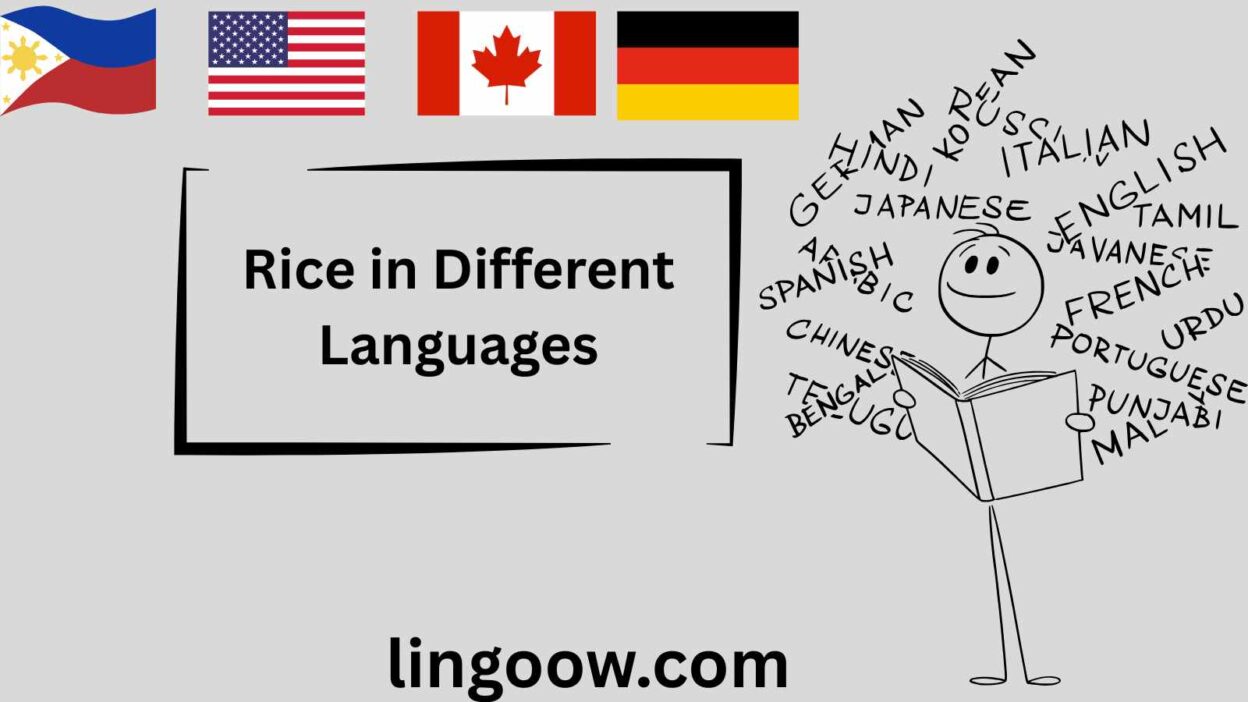Introduction: A Grain That Tells a Story
Rice is more than just a staple food; it’s a thread woven into the fabric of countless cultures, a symbol of sustenance, community, and celebration. I still remember my grandmother’s kitchen, the rhythmic clatter of a wooden spoon stirring a pot of steaming jasmine rice, its fragrance filling the air with memories of family gatherings. Across the globe, rice carries similar emotional weight—whether it’s the centerpiece of a Japanese sushi roll, the heart of a spicy Indian biryani, or the soul of a West African jollof. This humble grain transcends borders, connecting people through shared meals and stories. In this blog post, we’ll explore how the word for “rice” is expressed in different languages and cultures, revealing the universal bond it creates while celebrating the unique ways it shapes traditions worldwide.
Reference Table: The Word for “Rice” in 15 Languages
| Language | Word for Rice | Cultural/Linguistic Insight |
|---|---|---|
| Spanish | Arroz | Derived from Arabic “al-ruzz,” reflecting Spain’s historical ties to Moorish culture. |
| French | Riz | A simple, elegant term, often tied to sophisticated dishes like risotto in French cuisine. |
| Mandarin | Mǐ (米) | A fundamental word in Chinese, symbolizing sustenance and linked to agricultural heritage. |
| Hindi | Chāwal | Common in everyday meals, often tied to rituals like weddings where rice is auspicious. |
| Japanese | Gohan | Also means “meal,” showing rice’s centrality to Japanese food culture. |
| Arabic | Ruz | A staple in Middle Eastern diets, often flavored with spices in dishes like kabsa. |
| Swahili | Mchele | Reflects rice’s importance in East African coastal cuisines, often paired with coconut. |
| Zulu | Ilayisi | Borrowed from English, showing colonial influence on South African languages. |
| Yoruba | Iresi | Tied to communal meals, often used in offerings during traditional ceremonies. |
| Maori | Raihi | A loanword from English, adapted to fit Maori phonetics, used in modern contexts. |
| Hawaiian | Laika | Reflects rice’s integration into island cuisine, often paired with local flavors. |
| Cherokee | Tuya | Linked to agricultural traditions, though less central than corn in Cherokee culture. |
| Korean | Ssal | A core element of Korean meals, symbolizing nourishment and family unity. |
| Italian | Riso | Central to dishes like risotto, with regional variations in preparation. |
| German | Reis | Used in hearty dishes, often reflecting Germany’s practical approach to cuisine. |
European Languages: A Tapestry of Tradition
In Europe, rice is more than a side dish—it’s a canvas for culinary creativity. In Spanish, arroz carries echoes of the Moorish influence, seen in vibrant dishes like paella, where rice binds communities during festivals. The French riz evokes images of creamy risottos or delicate rice puddings, showcasing a refined approach to this grain. In Italian, riso is synonymous with risotto, a dish that demands patience and care, reflecting Italy’s love for slow, intentional cooking. German Reis appears in hearty, practical dishes, often paired with meats or vegetables, mirroring the country’s straightforward culinary ethos. Across Europe, rice adapts to local palates, yet its role as a comforting, versatile staple remains constant.
Asian Languages: The Heart of Every Meal
In Asia, rice is life itself. In Mandarin, mǐ is a word as ancient as China’s rice terraces, symbolizing prosperity and survival. It’s no surprise that rice is a cornerstone of Chinese festivals, from sticky rice dumplings during Dragon Boat to congee for comfort. In Hindi, chāwal is a daily necessity, often blessed during weddings as a symbol of fertility and abundance. Japanese gohan doubles as the word for “meal,” underscoring rice’s inseparable role in daily life, whether in sushi or onigiri. In Korean, ssal is the foundation of every table, paired with banchan (side dishes) to create harmony. In Arabic, spoken across 20 countries like Saudi Arabia, Egypt, and Morocco, ruz is spiced and celebrated in dishes like mandi, uniting families during Ramadan. From the rice paddies of Vietnam (gạo) to the biryanis of Pakistan (chawal), rice in Asia is a cultural anchor, reflecting both diversity and unity.
African Languages: A Celebration of Community
Across Africa’s 54 countries, rice is a shared joy, though its names and roles vary. In Swahili, spoken in 12 East African nations like Kenya and Tanzania, mchele is central to coastal dishes like pilau, infused with spices and coconut. In Zulu, spoken in South Africa, ilayisi reflects colonial linguistic influences but is embraced in local dishes like rice-based stews. Yoruba iresi, used in Nigeria, is often part of communal feasts or spiritual offerings, symbolizing gratitude. In languages like Amharic (ruz in Ethiopia) or Hausa (shinkafa in Nigeria), rice ties into celebrations, from weddings to harvest festivals. Across 20 African nations, including Ghana, Senegal, and Algeria, rice fosters community, whether in jollof rice rivalries or simple family meals.
Indigenous & Island Languages: Roots and Adaptation
In indigenous and island cultures, rice often blends tradition with adaptation. In Maori (raihi), spoken in New Zealand, rice is a modern addition, reflecting global influences on traditional diets. Hawaiian laika pairs rice with local flavors like spam musubi, a fusion of Native Hawaiian and Asian influences. In Cherokee (tuya), rice is less central than corn but still valued in modern dishes. Samoan alaisa, used in Samoa and other Pacific islands, is often cooked with coconut milk, reflecting Polynesian resourcefulness. Across 20 countries, from the Philippines (bigas) to Fiji (raisi), rice connects indigenous and island communities to both their roots and global trade, symbolizing resilience and creativity.
Cultural Insights: The Evolution of Rice
Rice’s journey began over 7,000 years ago in Asia, spreading through trade, conquest, and migration. In ancient China, rice was a currency and a sacred offering. In India, it’s tied to Vedic rituals, symbolizing life and prosperity. The Arabic ruz reflects the grain’s spread through the Silk Road, while Europe’s adoption of rice came via the Moors and later global exploration. In Africa, rice cultivation in regions like Senegal predates European contact, rooted in indigenous farming. Today, rice is a global unifier, yet its cultural significance varies—from Japan’s reverence for perfectly cooked rice to West Africa’s competitive jollof recipes. Its versatility reflects humanity’s ability to adapt and celebrate a single grain in countless ways.
Proverbs and Sayings: Wisdom in a Grain
Rice inspires wisdom across cultures:
- Chinese: “A single grain of rice can tip the scale.” (Small actions matter.)
- Indian: “Without rice, even the cleverest housewife cannot cook.” (Rice is essential to life.)
- Japanese: “A meal without rice is no meal at all.” (Rice is the heart of cuisine.)
- Nigerian (Yoruba): “Rice does not fall far from the pot.” (Like parent, like child.)
- Spanish: “Con arroz y cariño, todo sabe mejor.” (With rice and love, everything tastes better.) These sayings reflect rice’s role as a symbol of care, balance, and community, resonating across borders.
FAQs: Unraveling Rice’s Linguistic Journey
Why does the word for rice sound similar in many languages?
Words like arroz (Spanish), riz (French), and ruz (Arabic) share roots due to historical trade and conquest, particularly through Arabic influence during the Middle Ages.
What’s the oldest known use of the word for rice?
The Chinese mǐ dates back to ancient texts like the Shijing (Book of Odes), around 1000 BCE, reflecting rice’s deep agricultural roots.
How do cultural differences shape the word’s use?
In Japan, gohan implies a full meal, while in India, chāwal is tied to rituals. In Africa, words like mchele reflect local flavors, showing rice’s adaptability.
Conclusion: The Universal Language of Rice
Rice is more than a word—it’s a story of human connection, from ancient fields to modern tables. Whether it’s mǐ in a Chinese village, arroz in a Spanish fiesta, or mchele in a Tanzanian market, rice unites us through its ability to nourish both body and soul. Its names may differ, but its essence remains universal: a grain that brings people together. What’s the word for rice in your language, and how does it shape your traditions? Share your stories in the comments—we’d love to hear how this humble grain lives in your world!




